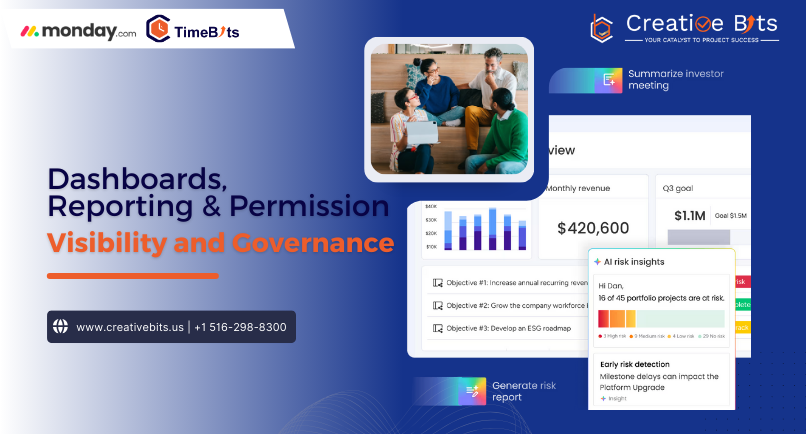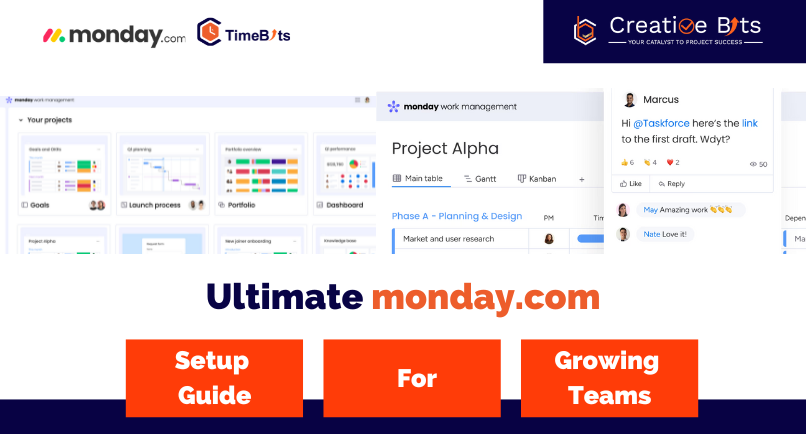Table of Contents
- Why Your Team Needs a Strategic Monday.com Setup
- Building the Foundations: Workspaces, Boards & Structure
- Automations & Workflow Builder: Remove Bottlenecks
- Dashboards, Reporting & Permissions: Visibility and Governance
- Best Practices for Scaling Your Monday.com Setup
- Conclusion: Transform Your Workflow Today
Why Your Team Needs a Strategic Monday.com Setup
Your monday.com setup guide starts here – and it's more critical than ever for growing teams in 2025. Growing teams need more than just enthusiasm and forward motion—they need organization. As small groups get bigger, problems can start to show up: tasks might be left hanging, responsibilities can get unclear, and it becomes harder to keep track of what's being done.
Using monday.com as your main work tool is a good idea—but if you don't plan it well from the beginning, things can get complicated quickly, and productivity might not keep up. According to Asana's Work Management Report, teams waste 60% of their time on work about work rather than skilled activities.
For Creative Bits, having a strong monday.com setup guide means teams can grow without confusion, prevent unnecessary work, and make sure everyone knows what needs to be done, when, and how. This comprehensive guide helps growing teams set up monday.com in a way that keeps things clear, encourages teamwork, and makes work more efficient—using boards, automations, workflows, and dashboards—with smart Creative Bits strategies that match your team's growth path.
1. Building the Foundations: Workspaces, Boards & Structure
Creating Your Monday.com Setup Guide Foundation
The first and most important step in creating a scalable monday.com system is setting up a clear and logical structure for workspaces and boards. Your monday.com setup guide should prioritize organization from day one.
Workspace Organization Best Practices:
- Organize workspaces based on main departments (marketing, operations, sales, customer support)
- Create boards that match specific processes (campaign tracking, project management, inventory)
- Use clear naming conventions and consistent folder systems
- Implement standard board types to prevent confusion

Inside each workspace, boards need to match specific processes—such as tracking a campaign launch, managing a project, or handling inventory restocking. Tasks on boards should be grouped into stages or time periods, and subtasks or checklists should be used thoughtfully to show how different parts depend on each other.
Essential Column Configuration
Columns such as status, due date, owner, priority, and dependency are important because they provide a clear structure. Adding custom fields related to the client, budget, or project type helps make things more specific. When you need to scale, copying templated boards—keeping their setup and rules the same—makes it easier to stay consistent across different teams.
Monday.com's template tools make this possible, which saves time and reduces mistakes. Another useful feature added in monday.com's April 2025 update is custom item IDs, which make it easier to track and refer to tasks throughout the system.
2. Automations & Workflow Builder: Remove Bottlenecks, Gain Velocity
Implementing Smart Automations in Your Monday.com Setup Guide
Once your boards are ready, the real power of your monday.com setup guide comes from automations and the Workflow Builder. Built-in recipes let you set up simple triggers that transform your workflow efficiency.
Key Automation Strategies:
- Status change notifications
- Due date reminders
- Automatic item movement between boards
- Recurring task generation
- Approval process workflows
The Workflow Builder also handles more complex workflows, such as:
- Branching logic based on conditions
- Conditional triggers with multiple criteria
- Strategic delays between actions
- Cross-board linking and updates
For instance, if one task's deadline changes, related tasks on other boards might need to update their dates too—automating this helps avoid the need for constant manual checks. According to Zapier's Automation Report, teams save up to 25 hours per week through workflow automation.
Advanced Workflow Optimization
David Simpson suggests regularly checking your automations to remove outdated ones and make sure they still fit your current processes. The April 2025 update to monday.com improved WorkForms, added better custom item IDs, and introduced more detailed permission settings, showing the platform's ongoing focus on improving workflow efficiency and control.
Planning your workflows with future growth in mind can prevent you from getting stuck using manual fixes later on. Your monday.com setup guide should include quarterly automation audits to ensure continued efficiency.
3. Dashboards, Reporting & Permissions: Visibility and Governance
Building Comprehensive Dashboards in Your Monday.com Setup Guide
As teams get bigger, it's important to have clear visibility into work and strong governance to stop unnecessary work from getting out of control. A proper monday.com setup guide emphasizes dashboard configuration as a critical component.
Dashboard Configuration Essentials:
- KPI tracking widgets
- Real-time deadline monitoring
- Workload distribution charts
- Task completion trends
- Team performance metrics
Monday.com dashboards let you bring together data from different boards, helping leaders track key performance indicators, upcoming deadlines, how work is spread out, and tasks that are past due, all in real time.

Permission Management Strategy
Setting up permissions is also key to your monday.com setup guide:
- Admin roles: Full system control and configuration
- Editor roles: Content creation and modification rights
- Viewer roles: Read-only access for stakeholders
With the April 2025 feature update, monday.com improved its permission controls and introduced custom item IDs, allowing for more precise management of template propagation and board editing.

Reporting Best Practices
Reporting shouldn't be fixed; it should help leaders look into trends like:
- Repeated delays in specific workflows
- Bottleneck identification
- Resource allocation inefficiencies
- Missed deadline patterns
4. Best Practices for Scaling Your Monday.com Setup
Scaling Strategies for Your Monday.com Setup Guide
Your monday.com setup guide should include these scaling best practices:
Template Standardization
- Create master templates for recurring projects
- Document template usage guidelines
- Version control for template updates
Integration Planning
- Connect with essential tools (Slack, Google Workspace, Microsoft Teams)
- API utilization for custom integrations
- Webhook configuration for real-time updates
Training and Onboarding
- Develop comprehensive training materials
- Create video tutorials for common tasks
- Establish monday.com champions within teams
Conclusion: Make Monday.com Work For You
Setting up monday.com properly from the start is like building a solid base for a tall building—it requires some work upfront, but saves you a lot of time and effort later. This monday.com setup guide provides the foundation for sustainable growth.
For teams that are growing, putting in place clear board structures, smart automations, useful dashboards, and solid permission settings helps you expand smoothly without getting lost in confusion. We at Creative Bits are here to help you make monday.com more than just another tool—it should be the core of your day-to-day operations.
If you're ready to transform your monday.com account from a bunch of boards into a powerful tool for growth, book a Discovery Call with Creative Bits' monday.com experts. We'll go over your setup, find any roadblocks, and design a workflow system that supports your team's goals moving forward.

 monday.com Services
monday.com Services



